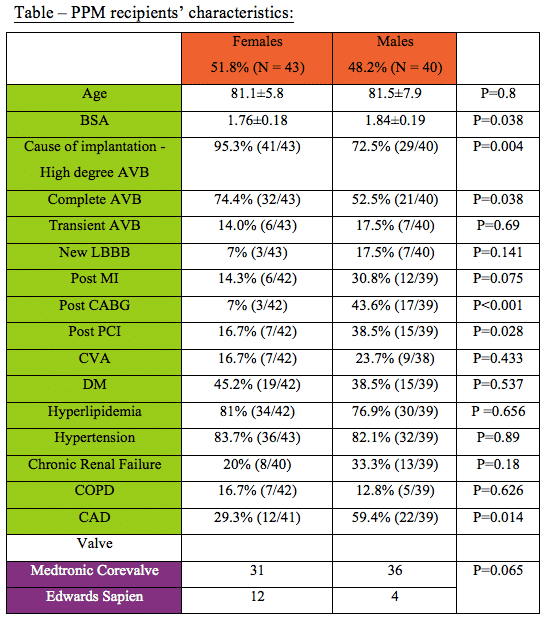Introduction: Transcatheter aortic valve replacement (TAVR) is an emerging therapy for patients with severe aortic stenosis. It is, however, associated with irreversible conduction blocks. Permanent pacemaker (PPM) implantation rates are reported in up to 25% and 6% of implanted patients with Medtronic Corevalve system and Edwards Sapien XT system, respectively. We sought to evaluate gender differences in post-TAVR PPM recipients.
Methods: The study included 440 consecutive patients (55% female) who underwent TAVR between 2008-2014.
Results: Eighty-three patients (18.9%) received PPM due to evidence of high degree AVB (84%) or new onset bundle branch block (BBB) accompanied by additional conduction disorders (16%). Of them, 43 (51.8%, p=0.57) were females, 31 (72%) received Medtronic Corevalve and 12 (28%) received Edwards Sapein valves. Females had less evidence of CAD and fewer interventions (table). We found neither epidemiological nor clinical predictors for developing significant conduction disorders post TAVR. While 52.5% of males received PPM due to complete AVB, the vast majority of females (74.4%) received PPM due to evidence of complete AVB (p=0.038). Moreover, at 24 months follow-up females had higher rates of pacemaker dependency with evidence of HAVB (41% vs, 8.3% p=0.046).
Conclusion: Among PPM recipients following TAVR, females had developed more severe conduction disorder compared to males. In addition, at 2-years follow-up, females were found to have higher rates of pacemaker dependency and HAVB. These may imply for more severe injury to the conduction system among females. Further research should be conducted in order to better characterize these differences.


